Creating simple formulas
Creating simple formulas
A convenient and time-saving feature of Google Sheets is its ability to add, subtract, multiply, and divide numerical information for you. Google Sheets uses mathematical expressions called formulas that make handling these calculations easy. In this lesson, we'll focus on formulas that contain one mathematical operator.
Most of the time, you will be using a cell's address in the formula. This is called using a cell reference. The advantage of using cell references is that you can change a value in a referenced cell and the formula will automatically recalculate. Using cell references in your formulas will make sure the values in your formulas are accurate.
Watch the video below to learn how to work with simple formulas in Google Sheets.
Mathematical operators
Google Sheets uses standard operators for formulas: a plus sign for addition (+), minus sign for subtraction (-), asterisk for multiplication (*), forward slash for division (/), and caret (^) for exponents.
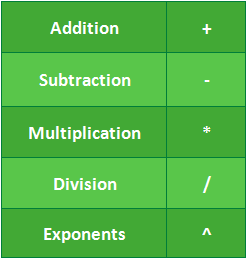
All formulas must begin with an equals sign (=). This is because the cell contains—or is equal to—the formula and the value it calculates.
Using cell references
When a formula contains a cell address, it is using a cell reference. Creating a formula with cell references is useful because you can update the numerical values in cells without having to rewrite the formula.

By combining a mathematical operator with cell references, you can create a variety of simple formulas in Google Sheets. Formulas can also include a combination of a cell reference and a number.

Creating formulas
In our example, we'll use simple formulas and cell references to help calculate a budget.
To create a formula:
- Select the cell that will display the calculated value.

- Type the equals sign (=).
- Type the cell address of the cell you want to reference first in the formula. A dotted border will appear around the cell being referenced.

- Type the operator you want to use. For example, type the addition sign (+).
- Type the cell address of the cell you want to reference second in the formula.
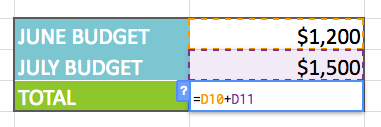
- Press the Enter key on your keyboard. The formula calculates, and Google Sheets displays the result.
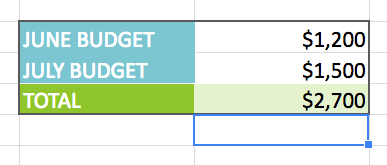
To see how the formula recalculates, try changing the value in either cell. The formula automatically displays the new value.
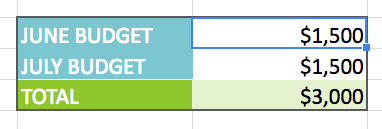
Google Sheets will not always tell you if your formula contains an error, so it's up to you to check all of your formulas. To learn how to do this, read our article on why you should Double-Check Your Formulas.
To create a formula using the point-and-click method:
Rather than type cell addresses, you can point and click the cells you want to include in your formula.
- Select the cell that will display the calculated value.
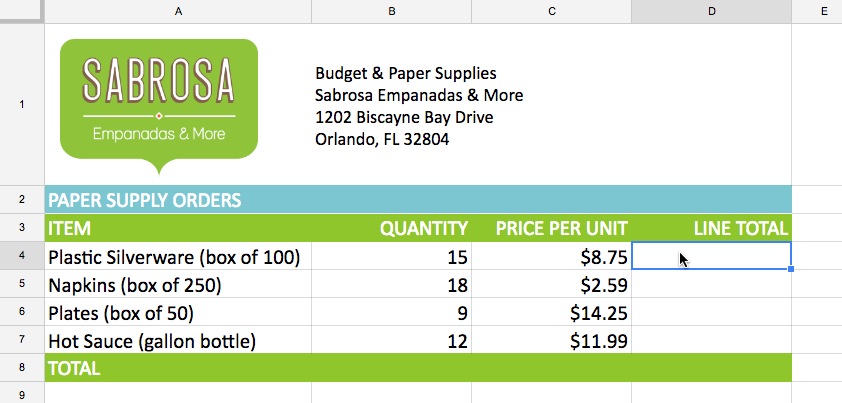
- Type the equals sign (=).
- Click the cell you want to reference first in the formula. The address of the cell appears in the formula.
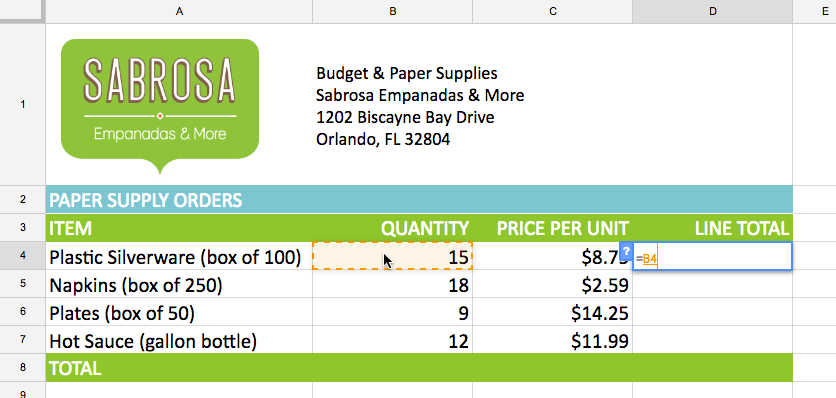
- Type the operator you want to use in the formula. For example, type the multiplication sign (*).
- Click the cell you want to reference second in the formula. The address of the cell appears in the formula.
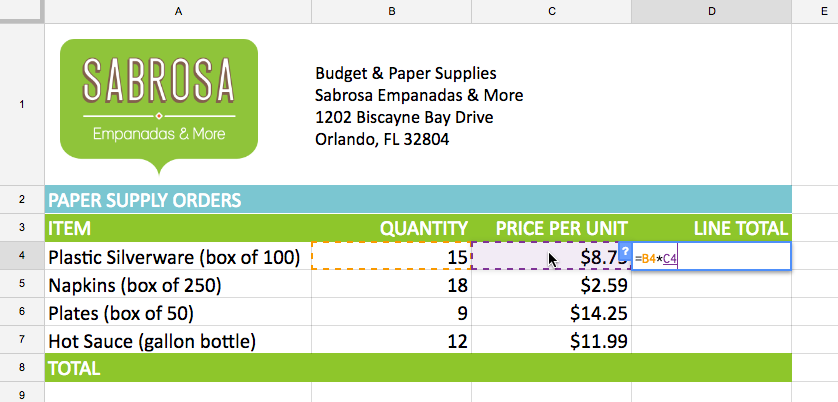
- Press the Enter key on your keyboard. The formula will be calculated, and the value will appear in the cell.
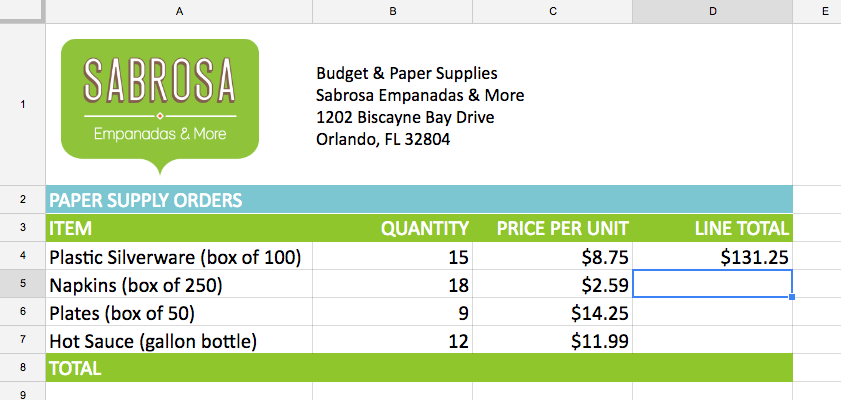
To edit a formula:
Sometimes you may want to modify an existing formula. In our example, we typed an incorrect cell address in our formula, so we need to correct it.
- Double-click the cell containing the formula you want to edit. The formula will be displayed in the cell.
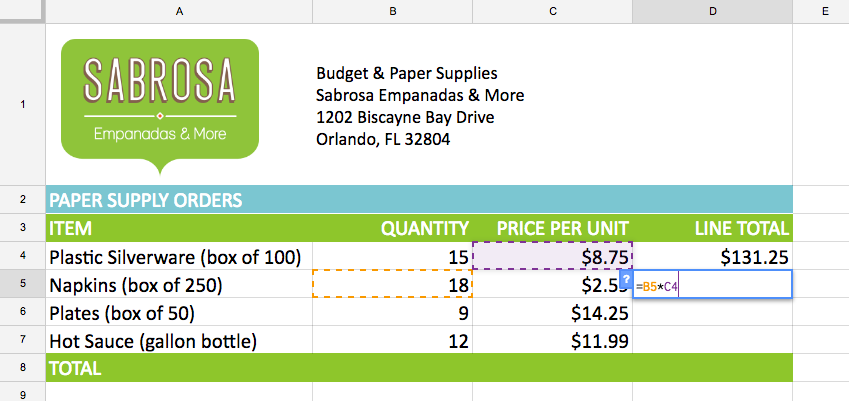
- Make the desired edits to the formula. In our example, we will replace C4 with C5.
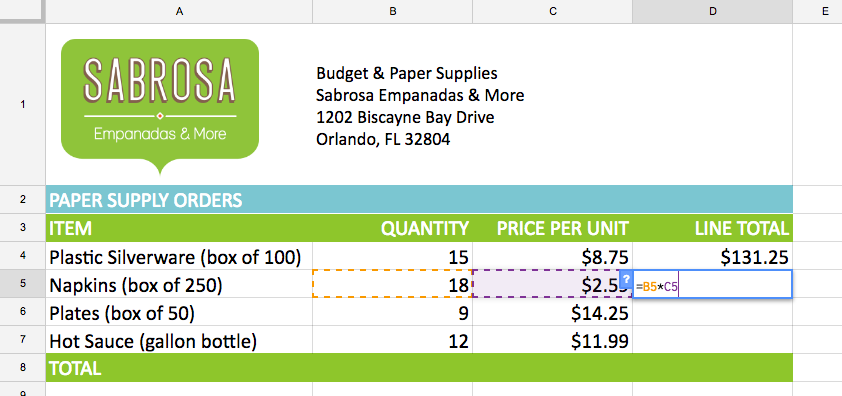
- When you're finished, press the Enter key on your keyboard. The formula recalculates, and the new value displays in the cell.
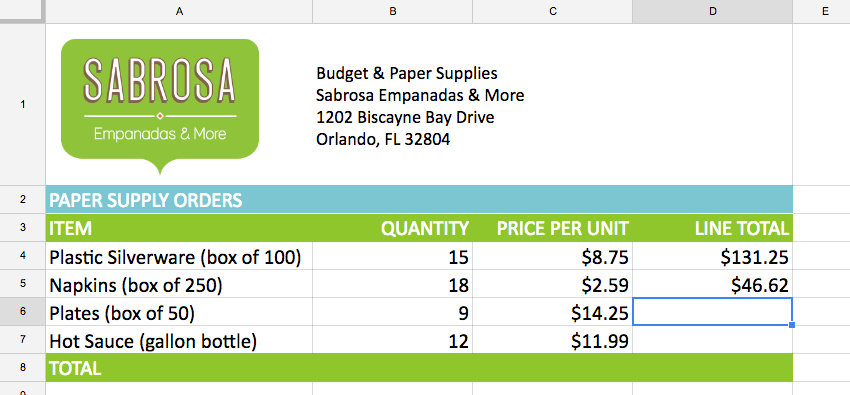
Challenge!
- Open our example file. Make sure you're signed in to Google, then click File > Make a copy.
- Select the Challenge sheet.
- In cell D4, create a formula that multiplies cells B4 and C4. Be sure to use cell references.
- Use the fill handle to copy the formula to cells D5 and D6.
- In cell D7, create a formula that adds cells D4, D5, and D6.
- Change the quantity in cell B4 to 15. You should also see cells D4 and D7 change.
- When you're finished, your spreadsheet should look something like this:
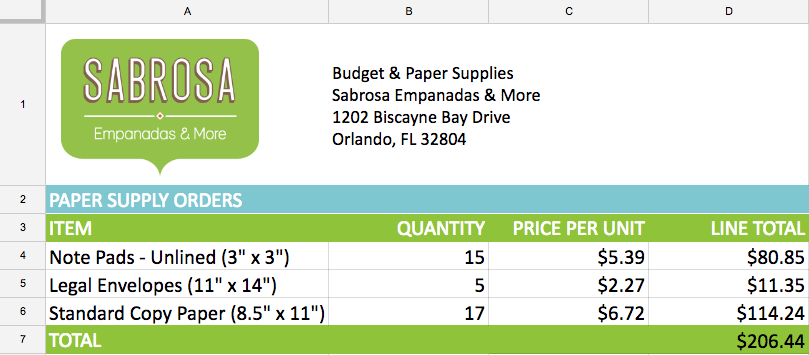
Lesson 13: Creating Complex Formulas
Introduction
You may have experience working with formulas that contain only one operator, such as 7+9. More complex formulas can contain several mathematical operators, such as 5+2*8. When there's more than one operation in a formula, the order of operations tells Google Sheets which operation to calculate first. To write formulas that will give you the correct answer, you'll need to understand the order of operations.
Watch the video below to learn how to create complex formulas.
Order of operations
Google Sheets calculates formulas based on the following order of operations:
- Operations enclosed in parentheses
- E****xponential calculations (3^2, for example)
- M****ultiplication and division, whichever comes first
- A****ddition and subtraction, whichever comes first
A mnemonic that can help you remember the order is Please Excuse My Dear Aunt Sally.
Click the arrows in the slideshow below to learn how the order of operations is used to calculate formulas in Google Sheets.
arrow_back_ios* 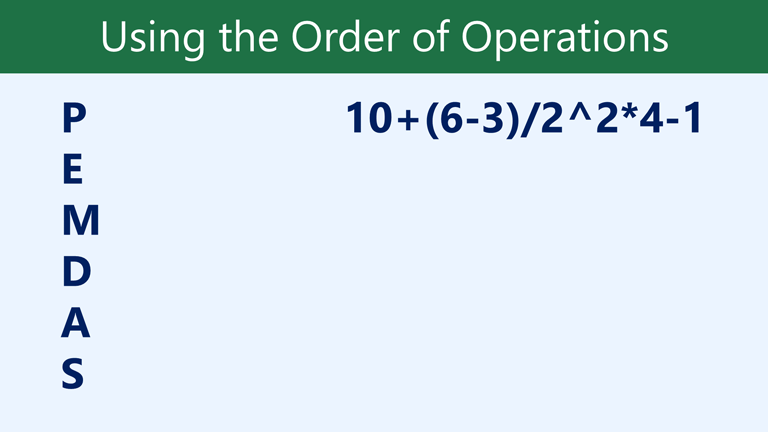 While this formula may look complicated, we can use the order of operations step by step to find the right answer.
While this formula may look complicated, we can use the order of operations step by step to find the right answer.
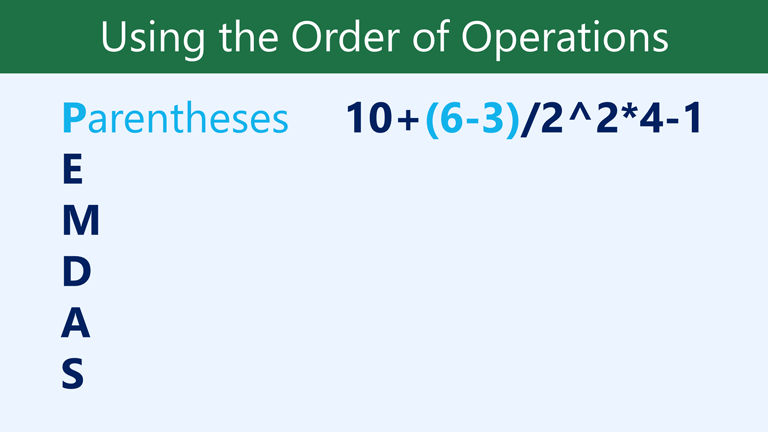 First, we'll start by calculating anything inside parentheses. In this case, there's only one thing we need to calculate: 6-3=3.
First, we'll start by calculating anything inside parentheses. In this case, there's only one thing we need to calculate: 6-3=3.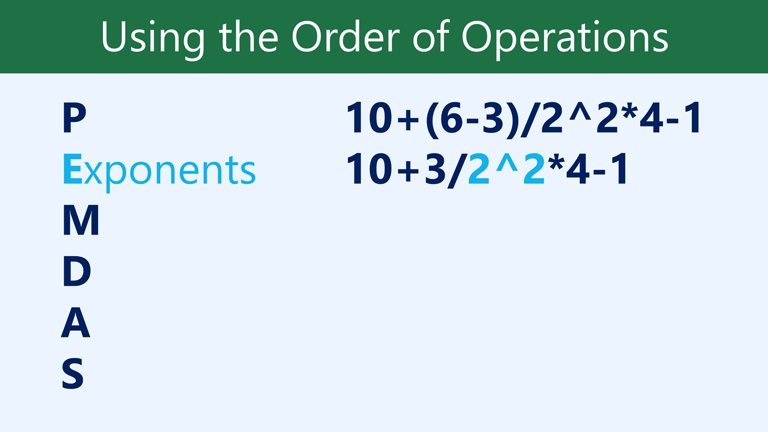 As you can see, the formula already looks simpler. Next, we'll look to see if there are any exponents. There is one: 2^2=4.
As you can see, the formula already looks simpler. Next, we'll look to see if there are any exponents. There is one: 2^2=4.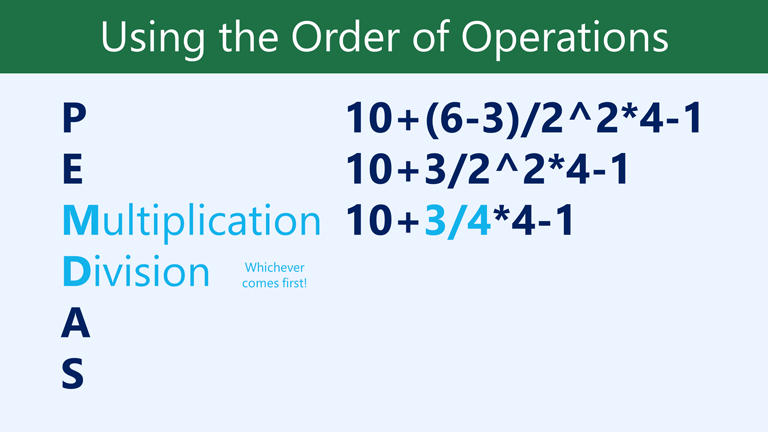 Next, we'll solve any multiplication and division, working from left to right. Because the division operation comes before the multiplication, it's calculated first: 3/4=0.75.
Next, we'll solve any multiplication and division, working from left to right. Because the division operation comes before the multiplication, it's calculated first: 3/4=0.75. Now, we'll solve our remaining multiplication operation: 0.75*4=3.
Now, we'll solve our remaining multiplication operation: 0.75*4=3.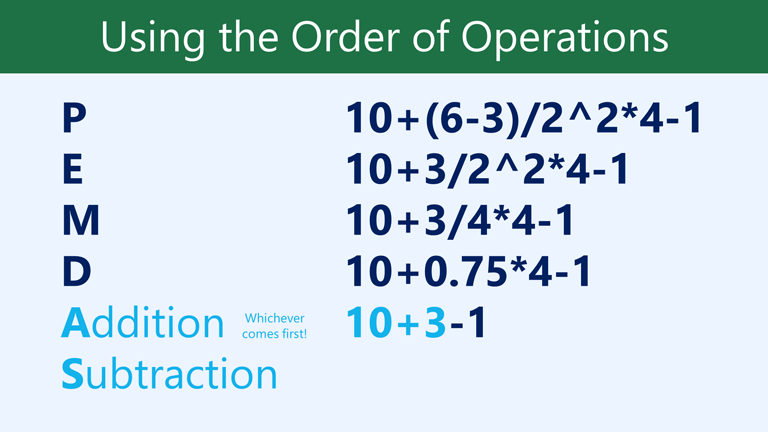 Next, we'll calculate any addition or subtraction, again working from left to right. Addition comes first: 10+3=13.
Next, we'll calculate any addition or subtraction, again working from left to right. Addition comes first: 10+3=13.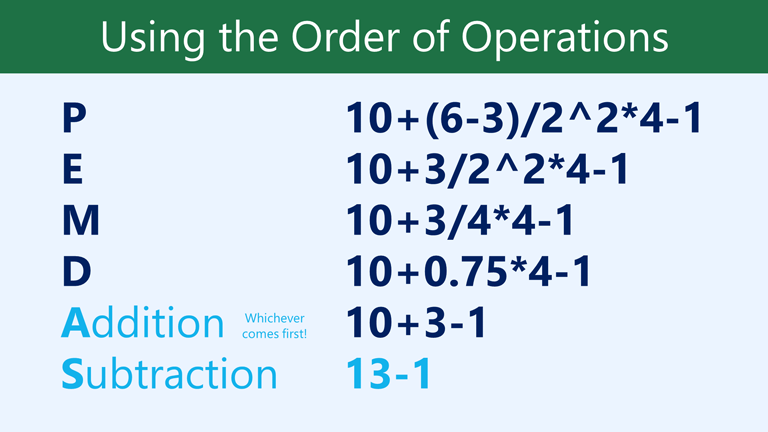 Finally, we have one remaining subtraction operation: 13-1=12.
Finally, we have one remaining subtraction operation: 13-1=12.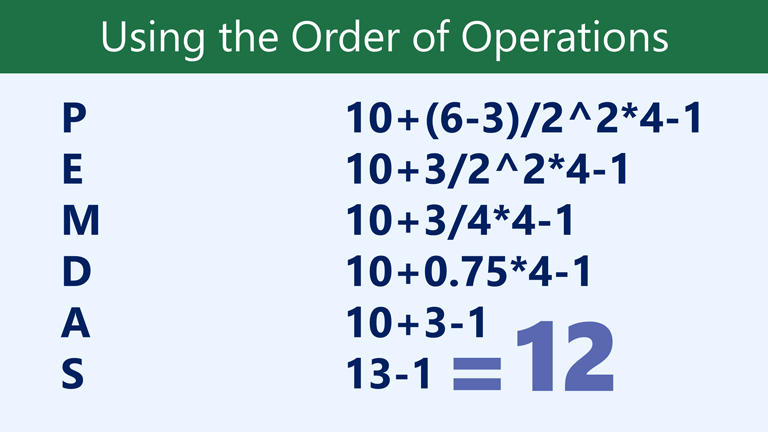 Now we have our answer: 12. And this is the exact same result you would get if you entered the formula into Excel.
Now we have our answer: 12. And this is the exact same result you would get if you entered the formula into Excel. arrow_back_ios
arrow_back_ios
Creating complex formulas
In the example below, we'll demonstrate how Google Sheets solves a complex formula using the order of operations. The complex formula in cell D6 calculates the sales tax by adding the prices together and multiplying by the 5.5% tax rate (which is written as 0.055).
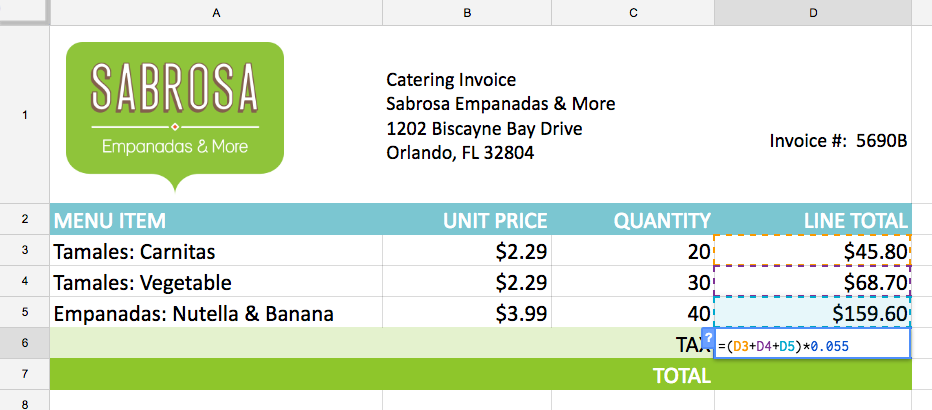
Google Sheets follows the order of operations and first adds the values inside the parentheses: (D3+D4+D5) = $274.10. Then it multiplies by the tax rate: $274.10*0.055. The result will show that the tax is $15.08.
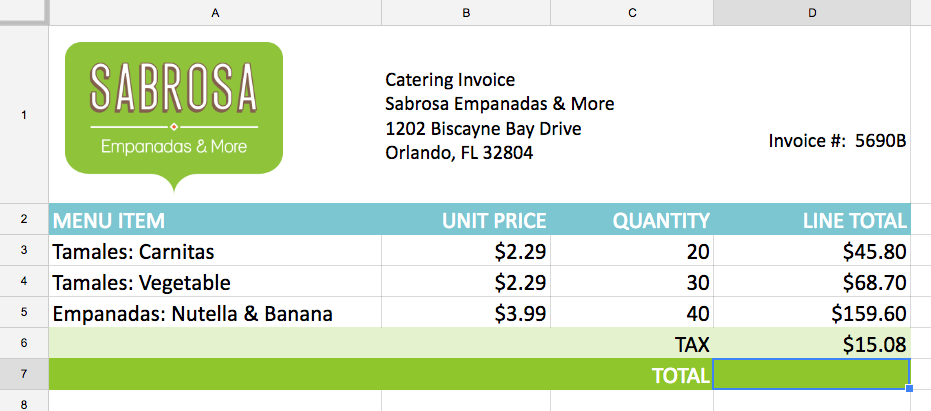
It's especially important to follow the order of operations when creating a formula. Otherwise, Google Sheets won't calculate the results accurately. In our example, if the** parentheses** are not included, the multiplication is calculated first and the result is incorrect. Parentheses are often the best way to define which calculations will be performed first in Google Sheets.
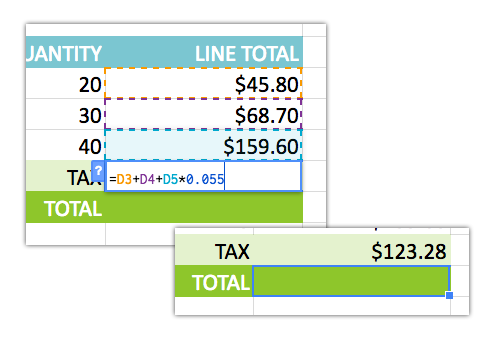
To create a complex formula using the order of operations:
In the example below, we'll use cell references along with numerical values to create a complex formula that will calculate the subtotal for a catering invoice. The formula will calculate the cost of each menu item first, then add these values.
- Select the cell that will contain the formula. In our example, we'll select cell C****5.

- Enter your formula. In our example, we'll type =B3*C3+B4*C4. This formula will follow the order of operations, first performing the multiplication: 2.79*****35 = 97.65 and 2.29*20 = 45.80. It then will add these values to calculate the total: 97.65+45.80.

- Double-check your formula for accuracy, then press Enter on your keyboard. The formula will calculate and display the result. In our example, the result shows that the subtotal for the order is $143.45.

Google Sheets will not always tell you if your formula contains an error, so it's up to you to check all of your formulas. To learn how to do this, read our article on why you should Double-Check Your Formulas.
Challenge!
- Open our example file. Make sure you're signed in to Google, then click File > Make a copy.
- Select the Challenge sheet. Let's say we want to compare two discounts. The first discount takes 20% off the total, and the second discount takes $30 off the total.
- In cell D6, create a formula that calculates the total using the 20% off discount. Hint: Because we're taking 20% off, 80% of the total will remain. To calculate this, multiply 0.80 by the sum of the line totals.
- In cell D7, create a formula that subtracts 30 from the total.
- When you're finished, your spreadsheet should look like this:

[
